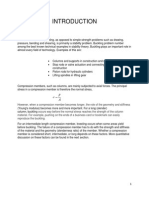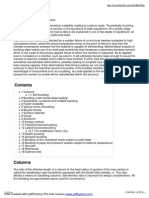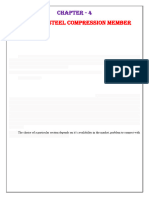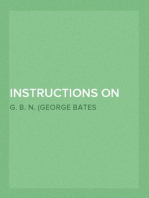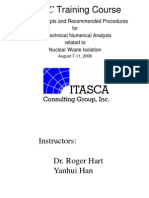10 A
10 A
Uploaded by
adnandjCopyright:
Available Formats
10 A
10 A
Uploaded by
adnandjOriginal Description:
Original Title
Copyright
Available Formats
Share this document
Did you find this document useful?
Is this content inappropriate?
Copyright:
Available Formats
10 A
10 A
Uploaded by
adnandjCopyright:
Available Formats
10a.
Buckling
http://strengthandstiffness.com/10_buckling/page_10a.htm
10a. Buckling
(SSES Ch. 10.1-10.3) What is Buckling Euler Buckling Formula Radius of Gyration Slenderness Ratio Effective Length
Back | Index | Next
What is Buckling? When a slender member is subjected to an axial compressive load, it may fail by a condition called buckling. Buckling is not a failure of the material itself (as is yielding and fracture), but is due to geometric instability of the system.
Buckling animation.
Euler Buckling Formula Consider a column of length L, cross-sectional moment of inertia I, and Young's modulus E. Both ends are pinned so they can freely rotate and cannot resist a moment. The critical load Pcr required to buckle the pinnedpinned column is the Euler Buckling Load:
The Buckling Strength scr is the Euler Buckling Load divided by the column's cross-sectional area:
Buckled shape of a pinned-pinned column under compressive force.
The buckling strength is a new condition we need to check for columns in compression. Note that buckling is not dependent on material strength.
Radius of Gyration If all of the cross-sectional area A were massed a distance r away from the bending axis, the idealized lumped-area cross-section would have the same moment of inertia I as the actual crosssection if: I = Ar2 Distance r is the radius of gyration. There generally two bending axes to consider, and thus two radii of gyration:
1 od 3
27.7.2013 23:06
10a. Buckling
http://strengthandstiffness.com/10_buckling/page_10a.htm
Slenderness Ratio Slenderness ratio is a measure of how long the column is compared to its cross-section's effective width (resistance to bending or buckling). The slenderness ratio is the column's length divided by the radius of gyration.
Including the slenderness ratio and the radius of gyration reduces the Buckling Strength to:
Effective Length How a column is supported governs its buckling strength. The effective length Le accounts for differences in the end supports. The effective length is the length the column would be if it were to buckle as a pinned-pinned column. The buckling formula for any column is therefore:
Common end-conditions are given here: Effective Lengths for Columns with Various End Conditions PinnedEnd Condition Fixed-Free Fixed-Fixed Fixed-Pinned Pinned
The effective length is equal to the distance between points in the column where moment = 0 (between "pins"). This occurs when the curvature of the column changes. The fixed-free column is "mirrored" through the fixed end to visualize Le=2L.
Effective Length, Le Relative Buckling Strength 2 (~ 1/ Le ) for same L Top
L 1
2L 0.25
0.5L 4
0.7L 2
Back | Index | Next
2 od 3
27.7.2013 23:06
10a. Buckling
http://strengthandstiffness.com/10_buckling/page_10a.htm
Updated: 05/22/09 DJD
3 od 3
27.7.2013 23:06
You might also like
- BUCKLINGDocument18 pagesBUCKLINGShahril ShafiqNo ratings yet
- Final Project PPT (MB)Document72 pagesFinal Project PPT (MB)Aashka BhattNo ratings yet
- 10.1 Buckling: What Is Buckling Euler Buckling Formula Radius of Gyration Slenderness Ratio Effective LengthDocument3 pages10.1 Buckling: What Is Buckling Euler Buckling Formula Radius of Gyration Slenderness Ratio Effective LengthChusnadiNo ratings yet
- 4-CE523-Handout-Compression Members-1Document56 pages4-CE523-Handout-Compression Members-1ehabNo ratings yet
- BucklingDocument13 pagesBucklingVinit Ahluwalia100% (1)
- 07-04-2020 ADSS ClassDocument20 pages07-04-2020 ADSS ClassmonikaNo ratings yet
- BucklingDocument15 pagesBucklingAbhijeet SahuNo ratings yet
- Stability of StructuresDocument4 pagesStability of StructuresIssam HermiNo ratings yet
- Unit 4Document5 pagesUnit 4shadowsamaNo ratings yet
- Lecture 4 Compression MembersDocument25 pagesLecture 4 Compression MembersLhee Ann GarboNo ratings yet
- Intended Learning OutcomesDocument24 pagesIntended Learning OutcomesSteve BariaNo ratings yet
- Buckling A Mechanical Failure ModeDocument238 pagesBuckling A Mechanical Failure Modeindra100% (1)
- Buckling: From Wikipedia, The Free EncyclopediaDocument10 pagesBuckling: From Wikipedia, The Free EncyclopediaSherif GebalyNo ratings yet
- Buckling and Columns Omer PelinDocument22 pagesBuckling and Columns Omer Pelinyrmlfrkn1No ratings yet
- Compression MembersDocument9 pagesCompression Membersnoli90No ratings yet
- Behavior of Slender ColumnsDocument38 pagesBehavior of Slender Columnsرجاء صبرةNo ratings yet
- INTRODUCTION Column StabilityDocument13 pagesINTRODUCTION Column StabilityMohd Yasir PilusNo ratings yet
- Buckling in ColumnsDocument8 pagesBuckling in ColumnsnirgaNo ratings yet
- Som Unit - VDocument14 pagesSom Unit - Viliyasiliyas6721No ratings yet
- MODULO 5 Compression MembersDocument23 pagesMODULO 5 Compression Memberscarlomonsalve1No ratings yet
- Buckling - Wikipedia, The Free EncyclopediaDocument12 pagesBuckling - Wikipedia, The Free EncyclopediazidaaanNo ratings yet
- SdarticleDocument14 pagesSdarticleMOHAMED REDHA SOLTANINo ratings yet
- Compression MemberDocument12 pagesCompression MemberSaurav RoyNo ratings yet
- Buckling PhenomenaDocument305 pagesBuckling PhenomenaManoj PradhanNo ratings yet
- COMPRESSION MEMBERS Full copyDocument51 pagesCOMPRESSION MEMBERS Full copyLJ IDANE ARANASNo ratings yet
- Leс3Document22 pagesLeс3PaulNo ratings yet
- Column Design-3-24Document22 pagesColumn Design-3-24Krishnakanth ChidreNo ratings yet
- Compression MemberDocument7 pagesCompression MemberaxmedNo ratings yet
- Design of Steel Structure BeamDocument17 pagesDesign of Steel Structure BeamShahrah ManNo ratings yet
- Unit6 MCNDocument24 pagesUnit6 MCNNithesh ShamNo ratings yet
- Compression MembersDocument8 pagesCompression MembersAbhi ANo ratings yet
- Design of Beams in Structural SteelDocument15 pagesDesign of Beams in Structural SteelMaqsood92% (13)
- BucklingDocument14 pagesBucklingmasoud_968370957No ratings yet
- 2.slender ColumnsDocument59 pages2.slender ColumnsIrfat SharminNo ratings yet
- ColumnsDocument5 pagesColumnsayalwNo ratings yet
- ColumnsDocument13 pagesColumnsVinod KumarNo ratings yet
- BucklingDocument7 pagesBucklingHarianto ArieNo ratings yet
- Steel Design Basic ConceptsDocument3 pagesSteel Design Basic ConceptsmithunNo ratings yet
- BucklingDocument8 pagesBucklingalphading100% (1)
- LOAD Cell NotesDocument15 pagesLOAD Cell NotesLakshmanan VenkateswaranNo ratings yet
- Deflection of Cantilever BeamDocument15 pagesDeflection of Cantilever BeamWaqas GujjarNo ratings yet
- Concrete Column PresentationDocument14 pagesConcrete Column PresentationkabirNo ratings yet
- Unit - Iv: Limt State Design of ColumnsDocument26 pagesUnit - Iv: Limt State Design of ColumnsTesfa HunderaNo ratings yet
- 7-Column Analysis and DesignDocument87 pages7-Column Analysis and Designhamadamjad047No ratings yet
- Shear Strength and Deformation Capacity For RC ColumnsDocument15 pagesShear Strength and Deformation Capacity For RC Columnsundf25No ratings yet
- 09 - Ana. & Design of BeamsDocument62 pages09 - Ana. & Design of BeamsSana'a AamirNo ratings yet
- Slender Columns (Theory)Document19 pagesSlender Columns (Theory)Arian AhmedNo ratings yet
- COLUMNPLAN2 RDocument35 pagesCOLUMNPLAN2 RAnonymous nwByj9LNo ratings yet
- CHP 6 (Shear and Diagonal Tension in Beams)Document33 pagesCHP 6 (Shear and Diagonal Tension in Beams)shirahmad.7171No ratings yet
- Steel Columns: Er. Rajinder Kumar (M.E. Civil) Sen. Lecturer G.P. College, BatalaDocument34 pagesSteel Columns: Er. Rajinder Kumar (M.E. Civil) Sen. Lecturer G.P. College, BatalaPrabhumk07No ratings yet
- Prestressed Cantilever and Continuous Beam - Seminar - Group 5Document30 pagesPrestressed Cantilever and Continuous Beam - Seminar - Group 5Ganesh MistercoolNo ratings yet
- 4compression Members PDFDocument59 pages4compression Members PDFkim suarezNo ratings yet
- Rajan ColnDocument52 pagesRajan ColnrajanciviltnebNo ratings yet
- Slender Column Test For Different End CondDocument4 pagesSlender Column Test For Different End CondJubaer RabbyNo ratings yet
- AMSM Module 4Document27 pagesAMSM Module 4Shaji EtNo ratings yet
- Lecture 4 - Comp. Members-1Document83 pagesLecture 4 - Comp. Members-1Usama MustafaNo ratings yet
- Chapter Five Buckling of Compression MembersDocument18 pagesChapter Five Buckling of Compression MembersYalem MesfinNo ratings yet
- Instructions on Modern American Bridge BuildingFrom EverandInstructions on Modern American Bridge BuildingNo ratings yet
- Cylindrical Compression Helix Springs For Suspension SystemsFrom EverandCylindrical Compression Helix Springs For Suspension SystemsNo ratings yet
- Material Properties E 29,000,000 Lb/in Ȟ 3 Weight Density 0.28 Lb/in 10" Y 200 Rad/secDocument4 pagesMaterial Properties E 29,000,000 Lb/in Ȟ 3 Weight Density 0.28 Lb/in 10" Y 200 Rad/secadnandjNo ratings yet
- Losses: HollowcoreDocument4 pagesLosses: HollowcoreadnandjNo ratings yet
- Scia Engineer Fact Sheet: Surface Load GeneratorsDocument2 pagesScia Engineer Fact Sheet: Surface Load Generatorsadnandj100% (1)
- CAD and BIM - ArchiCAD-libreDocument32 pagesCAD and BIM - ArchiCAD-libreadnandjNo ratings yet
- Slab CalculationDocument2 pagesSlab CalculationadnandjNo ratings yet
- Eccentric FootingDocument6 pagesEccentric Footingadnandj67% (3)
- 10a-Ex. Buckling Examples: GivenDocument2 pages10a-Ex. Buckling Examples: GivenadnandjNo ratings yet
- 8b. Strain Transformation: e S e S G TDocument2 pages8b. Strain Transformation: e S e S G TadnandjNo ratings yet
- 7b. Superposition: Moment MDocument2 pages7b. Superposition: Moment MadnandjNo ratings yet
- 6e. Shape: SectionDocument1 page6e. Shape: SectionadnandjNo ratings yet
- 8a-Ex. Stress Transformation Examples: GivenDocument3 pages8a-Ex. Stress Transformation Examples: GivenadnandjNo ratings yet
- 6d-Ex. Shear Stress Examples: GivenDocument2 pages6d-Ex. Shear Stress Examples: GivenadnandjNo ratings yet
- 9a. Failure TheoriesDocument3 pages9a. Failure TheoriesadnandjNo ratings yet
- 6a. Introduction To Beams: What Is A Beam?Document1 page6a. Introduction To Beams: What Is A Beam?adnandjNo ratings yet
- 6c. Beam Deflection: Deflect V (X)Document2 pages6c. Beam Deflection: Deflect V (X)adnandjNo ratings yet
- 6b-Ex. Beam Bending Examples: GivenDocument2 pages6b-Ex. Beam Bending Examples: GivenadnandjNo ratings yet
- 6d. Shear Stress in BeamsDocument1 page6d. Shear Stress in BeamsadnandjNo ratings yet
- 4c. Energy MethodsDocument1 page4c. Energy MethodsadnandjNo ratings yet
- 4d-Ex. Connector Examples: GivenDocument1 page4d-Ex. Connector Examples: GivenadnandjNo ratings yet
- 6b. Bending in Beams: Moment Shear Distributed LoadDocument2 pages6b. Bending in Beams: Moment Shear Distributed LoadadnandjNo ratings yet
- 5a-Ex. Torsion Member Examples: GivenDocument3 pages5a-Ex. Torsion Member Examples: GivenadnandjNo ratings yet
- Combined FootingDocument18 pagesCombined Footingjklo12No ratings yet
- 전해콘덴서 Hitachi (3300mfd400vdc) Hcgf4aDocument13 pages전해콘덴서 Hitachi (3300mfd400vdc) Hcgf4aPalmNo ratings yet
- Properties of Philippine Woods LoadsDocument2 pagesProperties of Philippine Woods LoadsJoshua VicenteNo ratings yet
- ISCL Strainer PressureDropCalc BrochureDocument1 pageISCL Strainer PressureDropCalc BrochuregopinathsampathNo ratings yet
- CH 01Document20 pagesCH 01tjkyle14No ratings yet
- Summative Test g10 Quarter 2 Week 56 AutorecoveredDocument2 pagesSummative Test g10 Quarter 2 Week 56 AutorecoveredKATHLEEN FALCULANNo ratings yet
- Strmi1b Experiment 2 Lab ReportDocument22 pagesStrmi1b Experiment 2 Lab ReportmathetamphoNo ratings yet
- Electro Polishing of Surfaces Theory and ApplicationsDocument20 pagesElectro Polishing of Surfaces Theory and Applicationssbharanidharan2007No ratings yet
- School of Chemical Engineering Universiti Sains Malaysia EKC314: Transport Phenomena (MHU) (Questions On Chapter 2 and Chapter 3)Document7 pagesSchool of Chemical Engineering Universiti Sains Malaysia EKC314: Transport Phenomena (MHU) (Questions On Chapter 2 and Chapter 3)NajwaAinayaZawaidNo ratings yet
- Syllabus For Engineering Physics at NIT CalicutDocument32 pagesSyllabus For Engineering Physics at NIT CalicutKarthik P Moothedath100% (1)
- Evaluating Thermal Aging CharacteristicsDocument4 pagesEvaluating Thermal Aging Characteristicsmadridi2003No ratings yet
- The Importance of The Non-Newtonian Characteristics of BloodDocument25 pagesThe Importance of The Non-Newtonian Characteristics of BloodMohammed Al-AzawyNo ratings yet
- Lec 2 - Voltage SagDocument37 pagesLec 2 - Voltage SagÙdayà Nirrmàl FernàñdòNo ratings yet
- Transilvania University of BrasovDocument7 pagesTransilvania University of BrasovAndrei DenisNo ratings yet
- Iaea Flac CourseDocument203 pagesIaea Flac Coursegeotekdemir100% (2)
- Chapter - 3Document47 pagesChapter - 3Shailesh GuptaNo ratings yet
- Electrochemistry-Subjective TesTDocument1 pageElectrochemistry-Subjective TesTKanishq meenaNo ratings yet
- Review On Thermomechanical Processing of Advanced High Strength SteelsDocument130 pagesReview On Thermomechanical Processing of Advanced High Strength SteelsharishNo ratings yet
- Complete Metalsmith StudentDocument21 pagesComplete Metalsmith StudentSinisa VuckovicNo ratings yet
- İzmir Kâtip Çelebi University Department of Mechanical Engineering ME 262 Strength of Materials II Final Exam (Spring)Document8 pagesİzmir Kâtip Çelebi University Department of Mechanical Engineering ME 262 Strength of Materials II Final Exam (Spring)Bengü MNo ratings yet
- Design of Continuous Beams PDFDocument4 pagesDesign of Continuous Beams PDFBlend DlerNo ratings yet
- Biomimetic optical materials IntegrationDocument49 pagesBiomimetic optical materials IntegrationAdry DamaNo ratings yet
- Modeling and Finite Element Analysis On GTAW Arc and Weld PoolDocument12 pagesModeling and Finite Element Analysis On GTAW Arc and Weld Poolgu1000No ratings yet
- D0685-Phy-Paper 1Document18 pagesD0685-Phy-Paper 1PHANTOM GAMINGNo ratings yet
- 22CL 8.gas MigrationDocument48 pages22CL 8.gas MigrationEslam Atif Azkol100% (1)
- Free Electron Theory 1Document39 pagesFree Electron Theory 1guddu.diebackNo ratings yet
- Heating Curve WorksheetDocument3 pagesHeating Curve Worksheetdhruvin.prasanthNo ratings yet
- HSSRPTR - 2. Worksheet QP 2Document2 pagesHSSRPTR - 2. Worksheet QP 2AswithNo ratings yet
- General Chemistry 2 Q1 Summative Test 1Document3 pagesGeneral Chemistry 2 Q1 Summative Test 1MA. HAZEL TEOLOGO100% (1)
















